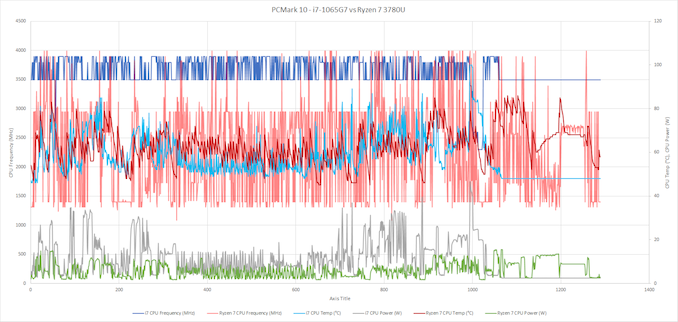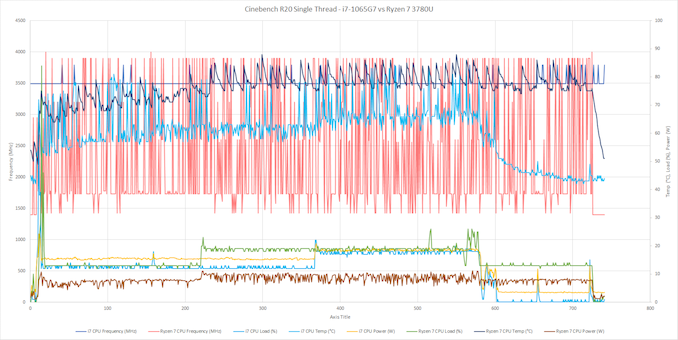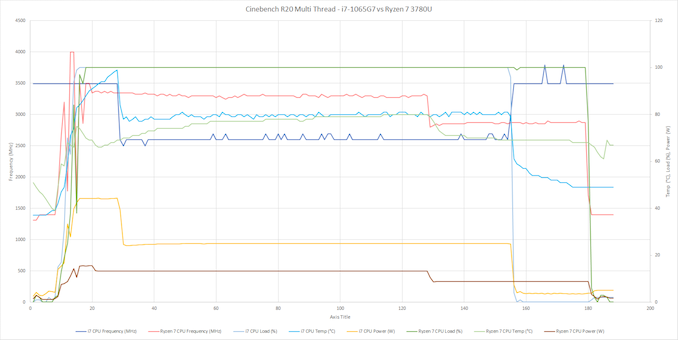The Microsoft Surface Laptop 3 Showdown: AMD's Ryzen Picasso vs. Intel's Ice Lake
by Brett Howse & Andrei Frumusanu on December 13, 2019 8:30 AM ESTBenchmark Analysis: Boost Behavior
Let’s dig into some of the testing to see how the systems responded during the benchmarks. We re-ran several of the tests while simultaneously monitoring the processor frequency, temperature, and power. Unfortunately for our comparison, the power polling results provided by our monitoring tools don’t seem to monitor the same power draw. The Intel power numbers are for the SoC package, but the AMD power numbers appear to be just the CPU cores, which is an unfortunate byproduct of testing two different platforms.
PCMark 10
PCMark 10 is a benchmark platform that attempts to simulate real-world tasks by running a variety of workflow, and the results were perhaps the most interesting of any of the benchmarks. There is a major discrepancy in how the AMD CPU behaved compared to the Intel. The Ice Lake platform kept the CPU frequency at a minimum of 3.5 GHz, with bursts to 3.9 GHz when under load. The Picasso processor was very aggressively switching from low frequency to high frequency, and was rarely indicating that it was over 3.0 GHz, but clearly demonstrating its higher peak frequency of 4.0 GHz in several locations. Both systems were fairly even in terms of CPU temperature, and Intel’s aggressive turbo levels were evident with peak power levels of 40 Watts for brief moments. The Ice Lake platform finished the benchmark about 200 seconds quicker than the Picasso system.
Cinebench R20 Single-Thread
We see somewhat similar results when only a single CPU core is loaded with the Picasso CPU frequency varying quite a bit. There’s also an average higher temperature on the AMD platform during this workload, and once again Ice Lake finishes the rendering quite a bit sooner thanks to its stronger CPU cores.
Cinebench R20 Multi-Thread
With all cores loaded the graph is considerably altered. Here the AMD processor is able to maintain a much higher frequency across its cores for much longer, while Intel's chip is only able to maintain 3.5 GHz for about 30 seconds before it runs out of headroom, dropping the cores down to around 2.6 GHz. But despite the lower frequency, the much higher IPC on Sunny Cove allows the Ice Lake platform to finish quite a bit sooner.













174 Comments
View All Comments
serendip - Saturday, December 14, 2019 - link
The pricing borders on the ridiculous for the AMD version of the SL3, on top of the Ice Lake variant not being available for consumers. I'm all for competition in the mobile chip arena but Ryzen Picasso is uncompetitive at $2000. Microsoft really made a mess this time. But then again, the 15" SL3 is a niche of a niche product, so they could be using this as an experiment for AMD on the next Surface Pro.MBarton - Monday, December 30, 2019 - link
The only reason Microsoft is using leftover Zen Picasso parts is because Intel's 10nm is so pathetic that they can't get enough working Intel parts to supply demand. So Microsoft got a cheap deal on old Zen+ parts to help fill the void. Low margin mobile CPU markets are not what AMD is focused on. AMD needs money and the profits are in the server market and HEDT market.Jhlot - Sunday, December 15, 2019 - link
"On purely CPU based tasks, Ice Lake really stretched its legs, and despite this being a 3.9 GHz chip, in single-threaded SPEC 2017, it managed to come very close to a 5.0 GHz Core i9-9900K with a massively higher TDP.Sunny Cove cores on Desktop are going to very good if Intel can get the darn things out.
eastcoast_pete - Sunday, December 15, 2019 - link
Maybe somebody at AT or here knows, but my favorite suspicion why MS even had a Ryzen mobile system on offer despite it being a full generation behind is that they didn't trust Intel getting their 10 nm Ice Lake fabbing straightened out in time, and didn't want to risk getting caught without pants. In other words, was this MS playing it safe with the AMD APU as second option just in case Intel came up short again? What's the word?heffeque - Sunday, December 15, 2019 - link
This sounds very plausible.MBarton - Monday, December 30, 2019 - link
Intel HASN'T gotten their 10nm Ice Lake "straightened out". Hence why Intel is suddenly mum on Ice Lake server parts. They've totally disappeared from presentations. Why anybody thought that Intel would get ICL "straightened out" now, out of the blue, is beyond me. 10nm is essentially dead.AntonErtl - Sunday, December 15, 2019 - link
As long as the Ryzen U chips don't get competetive idle power consumption, they will have a severe handicap in the laptop market. But for small fanless barebones systems (e.g., something like the Zotac ZBOX CI series), they should be quite appropriate. I wonder why we don't see them in that capacity.Farfolomew - Sunday, December 15, 2019 - link
10th Gen Comet Lake CPUs are better than Ryzen 3k APUs. Of course Ice Lake is going to dominate. Zen 3 better be decent to compete with Icelake on desktop.scineram - Monday, December 16, 2019 - link
What Icelake on desktop?maroon1 - Tuesday, December 17, 2019 - link
We won't see icelake on desktop even next year